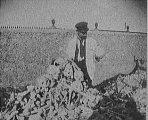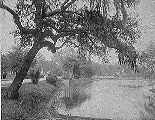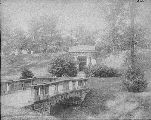Death of Jabal Al-Din Al-Runi, Sufi poet who is a popular companion of the Anatolian upper classes and of Christian monks. He is enshrined in the Green Dome, a mausoleum built especially for him by admirers at Konya.
| 1278 | - Edward I orders the remains of Arthur and Guenivere placed in a black marble tomb at Glastonbury Abbey. Their skulls are put on display and their bones wrapped in silk.
|
| 1294 | - Pope Boniface VIII prohibits the separate burial of the heart, but this is later withdrawn by Pope Benedict XI.
|
| 1296 | - Scots raiders scatter the bones of the saints kept in the priory at Hexham.
|
| 1300 to 1532 | - The Incas practice child sacrifice, burying the young victims atop lufty Andean peaks.
|
| 1313 | - The body of Gherado of Florence (d. 1250) is tried for heresy.
|
| 1314 | - Robert the Bruce brings the arm of St. Fillan to the battle of Bannockburn. He attributes his victory to the saint's intercession.
|
| 1315 | - Mondino de Luzzi performs the first public dissection of a human body for his students. His Anatomia becomes a key text.
|
| 1317 | - Emperor Rudolph I releases the body of Rabbi Meir of Rothenberg, fourteen after the spiritual master's death. Meir was imprisoned in 1286, but refused to accept his followers' offers of a ransom lest he set a precedent by which other rabbis might be kidnapped.
|
| 1318 | - Construction of the Ossurap at Kutná Hora (now Czech Republic) following the deathof thousands of citizens from the Plague.
|
| 1328 | - Death of Ibn Tamiya, who has been imprisoned for voicing his opposition to the worship of saints by Muslims. His tomb in the Sufi cemetery at Cairo becomes a shrine for many who come to venerate him.
|
| 1340 | - Pilgrims begin visiting a seventh century B.C. chamber tomb at Salamis, Cyprus, in the belief that it is the tomb or prison of Saint Catherine.
|
| 1348 | - The Black Death forces Venetians to abandon their usual custom of displaying the corpse. Instead, they bury the bodies almost immediately.
- Strasbourg's Christians hang 2000 Jews in retribution for their alledged spreading of the Black Death. The scaffolds are erected on a Jewish burial ground. Executions proceed despite two papal bulls exonerating the Jews.
|
| 1361 | - King Pedro of Portugal has the body of his Spanish lover, Inez de Castro exhumed and enthroned as his Queen. Castro was executed in 1355 by Pedro's father.
|
| 1367 | - The Council of York forbids "rousing the ghost" and other practical jokes on grieving relatives.
|
| 1380 | - St. Catherine of Sienna is decapitated after her death from a stroke so that her head may remain in Siena and her body may be interred at Santa Monica sopa Minerva in Rome.
|
| 1389 | - First reports of the liquefaction of the blood of St. Januarius (who may be apocryphal) at Naples.
|
| 1397 | - Construction of a mausoleum for Sufi saint Ahmed Yesevi begins. It is completed the following year.
|
| 1405 | - The Council of Nantes forbids dancing, juggling, the playing of games, and many other entertainments in cemeteries.
|
| 1410 | - Physicians perform an autopsy on Pope Alexander V to determine if he was poisoned. (They find no evidence.)
|
| 1425 | - John Wycliff (d. 1384) is tried for heresy.
|
| 1431 | - The ashes of Joan of Arc are thrown into the Seine.
|
| 1440 | - Florentine painter Andrea del Castagno paints a fresco on the façade of the Palazzo del Podesta showing men hanged as traitors. Andrea is thereafter known as Andreino degl’impiccati or "Andrew of the Hanged Men"
|
| 1457 | - The Scottish parliament mandates the use of churchyards for weekly archery practice.
|
| 1460 | - Roger van der Weyden paints The Seven Sacraments altarpiece. The last sacrament is, of course, extreme unction or the last rites.
|
| 1461 | - Thomas Paleologus bestows the head of St. Andrew on Pope Pius II. It remains in Rome until it is returned to the Patriarch of Constantinople by Pope Paul VI.
|
| 1477 | - The duc de Lorraine builds a chapel on the site of the mass grave where Charles the Bold and his army are interred, outside Nancy.
|
| 1479 | - John of Sahugan prophesies his own death, which takes place on June 11 of this year. His tomb attracts pilgrims, who report miracles.
|
| 1485 | - Workmen quarrying along the Appian Way find the perfectly preserved body of a beautiful Roman girl. Pope Innocent VIII orders "Julia, daughter of Claudius" to be buried in a secret place to prevent a neo-pagan cult from developing around her body.
|
| 1505 | - The Council of Edinburgh agrees to turn over one executed criminal each year for dissection.
|
| 1508 | - The remains of St. Dunstan are exhumed so that part of his crown can be serve as a holy relic.
|
| 1520 | - Denmark's King Christian II has the body of Swedish patriot Sten Sture dug up and burned along with that of Sture's small child.
|
| 1522 | - Portuguese merchants, arriving in India, find the purported tomb of St. Thomas the Apostle at Mylapore.
|
| 1527 | - Some of Pizarro's men first observe the process of head-shrinking in Peru.
|
| 1529 | - Göttigen is stricken with a plague so devastating that corpses must be buried eight to a grave. The same "sweating sickness" also strikes London, Hamburg, Bremen, Lübeck, Marburg, Augsburg, Vienna and Switzerland. The French are spared.
- The English Parliament sets a sliding scale of mortuary charges to be paid to the lord of the manor. Deceased persons owning less than 10 marks worth of property are exempted from all death tolls.
|
| 1530 | - The Ottoman sultan gives the body of St. John the Almsgiver to King Matthias of Hungary.
|
| 1533 | - First autopsy performed in the New World at Santo Domingo, Hispanola. Determines that Siamese twins have two separate souls. Father protests and pays for only one funeral.
|
| 1534 | - Michaeangelo finishes work on the Medici family tomb and moves to Rome.
|
| 1539 | - Soldiers of Henry VII pillage several famous churches and abbeys, destroying the tomb of King Arthur at Glastonbury and the tomb of Edward the Confessor in Westminster Abbey.
- Lutheran Phillip of Hesse removes the relics of Elizabeth of Hungary from her Marsburg Church and disposes of them.
|
| 1540 | - The bones of Thomas á Becket (d.1170) are exhumed and burned as punishment for high treason against the English king, Henry II.
|
| 1541 | - Protestant zealots destroy the relics of Saints Etheldreda, Sexburga, Wineburga, and Ermengild at Ely.
|
| 1542 | - Swiss traveller Joseph de Meggen witnesses the pillaging of the Salamis necropolis and buys several mementoes from the tomb robbers.
|
| 1543 | - Belgian anatomist Andreas Vesalius publishes his De Corporis Humani Fabrica in defiance of the Church's ban against dissection.
|
| 1555 | - The Pieta, depicting the Virgin Mary holding the body of the dead Christ, is finished by Michaelangelo.
- The town of Chatelet, France, rejects the idea of building a cemetery on the island of Macquerelle because citizens fear that those taking bodies to the cemetery will throw them in the River Seine.
|
| 1556 | - Holy Roman Emperor Charles V abdicates and spends the last three weeks of his life undergoing daily enactments of his own funeral at a Yuste monastery.
|
| 1558 | - Protestants burn St. Winnoc's Monastery, Bergues, Flanders, destroying many reputed saints' relics.
|
| 1559 | - Inca mummies publically preside over their last major feast. Afterwards, they hide under the skirts of saints.
- Vicq d'Azyr claims that people living next to cemeteries are the first to be infected and the longest to suffer in times of contagion.
|
| 1562 | - Pieter Brueghel paints The Triumph of Death.
- Calivinists destroy the crypt tomb of St. Irenaeus of Lyons.
|
| 1563 | - The Scottish Parliament provides that all parishes shall have a bier which shall be used to transport the bodies of the poor.
|
| 1564 | - Andreas Vesalius, noted anatomist and physician to the Holy Roman Emperor, misdiagnoses a Spanish nobleman as dead, killing the patient during the autopsy.
|
| 1565 | - London's Royal College of Physicians receives permission to perform dissections.
|
| 1566 | - The Assembly of Scotland prohibits church burials and denies violators religious priveleges.
|
| 1572 | - Pope Gregory XIII celebrate the St. Bartholomew's Day Massacre by orderng the lighting of bonfires. 50,000 Huguenots die at the instigation of Catherne de'Medici. Among the dead are Admiral de Coligny and the mathematician and logician Pierre de la Ramée.
|
| 1578 | - The Roman catacombs are rediscovered.
|
| 1579 | - Calvinists scatter the relics of St. Gudula at Brussels, Belgium.
|
| 1580 | - The Port of Rye, England requires corpses to purchase a license if they are to be buried in coffins.
|
| 1581 | - The Council of Rouen allows church burial for monks, the clergy, the rich, and "those who by their nobility, their actions, and their merits have distinguished themselves in the service of God and of the common good."
|
| 1587 | - Religious turmoil in Flanders promots the return of the relics of St. Leocadia to Toledo, Spain.
|
| 1588 | - Remains found at Messina, Sicily, are identified as relics of St. Placid and thirty companions who were killed by Saracen pirates from Spain: a remarkable occurence given that Placid lived in the 6th century and the Moors had not yet invaded Spain.
|
| 1589 | - Protestant officials discover, to their dismay, a competitive market for lambs and cattle offered at the tomb of St. Beuno, in Wales. Their owners buy them back, believing that the cattle "prospered marvellous well".
|
| 1592 | - Pilgrims visiting the tomb of lay brother Paschal Baylon, who dies this year, claim to hear knocking sounds from within. The reports will continue for 200 years. Baylon is canonized in 1690.
|
| 1593 | - A mausoleum is a key feature of Spain's recently completed Escorial Palace.
- The Scottish Parliament mandates that begger's prisons and stocks be placed in churchyards.
|
| 1594 | - The Turks burn the relics of St. Sava of Serbia, housed at Milesevo.
|
| 1595 | - Matthew Wall of Braughing, England, finally dies, several years after nearly being buried alive.
|
| 1598 | - The Scottish Parliament decrees that a black mort-cloth shall be "laid on the corpse of the poor."
- In his Les Cimetiéres sacrez, Bishop Henri de Sponde argues against mixing Catholic and Protestant burials, lest they provoke "sedition and quarrels."
|
| 1599 | - The tomb of St. Cecilia in Rome is opened. Her 1200 year old body shows little signs of decay. Exposure to the air, however, leads to its rapid disintegration.
|










